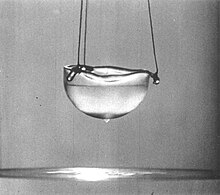Superfluidity


| Condensed matter physics |
|---|
 |
Superfluidity is the characteristic property of a
Superfluidity often co-occurs with Bose–Einstein condensation, but neither phenomenon is directly related to the other; not all Bose–Einstein condensates can be regarded as superfluids, and not all superfluids are Bose–Einstein condensates.[citation needed] Superfluids have some potential practical uses, such as dissolving substances in a quantum solvent.
Superfluidity of liquid helium
Superfluidity was discovered in helium-4 by Pyotr Kapitsa[2] and independently by John F. Allen and Don Misener[3] in 1937. Onnes possibly observed the superfluid phase transition on August 2 1911, the same day that he observed superconductivity in mercury.[4] It has since been described through phenomenology and microscopic theories.
In liquid helium-4, the superfluidity occurs at far higher temperatures than it does in
Ultracold atomic gases
Superfluidity in an ultracold
These dramatic excitations result in the formation of solitons that in turn decay into quantized vortices—created far out of equilibrium, in pairs of opposite circulation—revealing directly the process of superfluid breakdown in Bose–Einstein condensates. With a double light-roadblock setup, we can generate controlled collisions between shock waves resulting in completely unexpected, nonlinear excitations. We have observed hybrid structures consisting of vortex rings embedded in dark solitonic shells. The vortex rings act as 'phantom propellers' leading to very rich excitation dynamics.
— Lene Hau, SIAM Conference on Nonlinear Waves and Coherent Structures
Superfluids in astrophysics
The idea that superfluidity exists inside
In high-energy physics and quantum gravity
Superfluid vacuum theory (SVT) is an approach in theoretical physics and quantum mechanics where the physical vacuum is viewed as superfluid.[citation needed]
The ultimate goal of the approach is to develop scientific models that unify quantum mechanics (describing three of the four known fundamental interactions) with gravity. This makes SVT a candidate for the theory of quantum gravity and an extension of the Standard Model.[citation needed]
It is hoped that development of such a theory would unify into a single consistent model of all fundamental interactions, and to describe all known interactions and elementary particles as different manifestations of the same entity, superfluid vacuum.[citation needed]
On the macro-scale a larger similar phenomenon has been suggested as happening in the murmurations of starlings. The rapidity of change in flight patterns mimics the phase change leading to superfluidity in some liquid states.[16]
Light behaves like a superfluid in various applications such as
See also
- Boojum (superfluidity)
- Condensed matter physics
- Macroscopic quantum phenomena
- Quantum hydrodynamics
- Slow light
- Supersolid
References
- ^ a b "The Nobel Prize in Physics 1996 – Advanced Information". www.nobelprize.org. Retrieved 2017-02-10.
- S2CID 3997900.
- S2CID 4135906.
- ISSN 0031-9228.
- ^ "MIT physicists create new form of matter". mit.edu. 22 June 2005. Retrieved November 22, 2010.
- S2CID 7262637.
- S2CID 9128694.
- doi:10.1038/nphys704.
- S2CID 4423307.
- ^ "Lene Hau". Physicscentral.com. Retrieved 2013-02-10.
- ^ Hau, Lene Vestergaard (2003). "Frozen Light" (PDF). Scientific American: 44–51.
- ^ Hau, Lene (September 9–12, 2006). "Shocking Bose–Einstein Condensates with Slow Light". SIAM.org. Society for Industrial and Applied Mathematics.
- .
- .
- S2CID 586149.
- PMID 25264452.
Further reading
- Khalatnikov, Isaac M. (2018). An introduction to the theory of superfluidity. CRC Press. ISBN 978-0-42-997144-0.
- Annett, James F. (2005). Superconductivity, superfluids, and condensates. Oxford: Oxford Univ. Press. ISBN 978-0-19-850756-7.
- Guénault, Tony (2003). Basic superfluids. London: Taylor & Francis. ISBN 0-7484-0891-6.
- Svistunov, B. V., Babaev E. S., Prokof'ev N. V. Superfluid States of Matter
- Volovik, Grigory E. (2003). The Universe in a helium droplet. Int. Ser. Monogr. Phys. Vol. 117. pp. 1–507. ISBN 978-0-19-850782-6.
External links
 Quotations related to Superfluidity at Wikiquote
Quotations related to Superfluidity at Wikiquote Media related to Superfluidity at Wikimedia Commons
Media related to Superfluidity at Wikimedia Commons- Video: Demonstration of superfluid helium (Alfred Leitner, 1963, 38 min.)
- Superfluidity seen in a 2d fermi gas recent 2021 observation relevant for Cuprate superconductors

